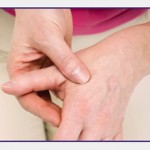We provide charity care at our hospital, but there are limits. For the cost of one year of Enbrel, we can provide immunizations to a thousand children.
Uncovering her lower legs, I understand why she cannot walk. The knees and hips are also contracted, her thighs nearly touching her abdomen, her knees flexed at 90º. If she were upright, she would appear in a perpetual squat. I rock her hip gently, and she cries out. There is roughly half a cup of fluid in each knee. Everywhere I lightly touch a joint, there is warmth and a hint of redness.
In such cases, something can always be done to help, to offer some measure of comfort, but I know my tools are limited. Hip, knee and shoulder replacement might restore her ability to walk and reduce pain, but finding an orthopedic surgeon willing to tackle the job—gratis, in an 80 lb. patient is a tall order. I make a mental note to ask Dr. Macaden on our way home if this is even a remote possibility.
“The methotrexate,” I ask, “what is the dose?”
“Fifteen mg weekly,” Dr. Macaden answers. “We wish we could increase the dose, but her liver enzymes are slightly elevated. We are giving her daily folic acid and will be drawing blood today.”
I quietly evaluate our options. According to Dr. Macaden, hydroxychloroquine was discontinued years before due to a lack of efficacy. In the face of elevated liver enzymes, leflunomide is contraindicated.
“Sulfasalazine?” I ask. “Has she had a trial of sulfasalazine?”
“To substitute for the methotrexate?”
“No, to add to it. It may be of some benefit,” I answer. Dr. Macaden jots down the dosage and silently nods. “And the prednisone, perhaps you can nudge that up as well,” I add.
Foremost in my mind is whether a trial of a biologic could be prescribed, but before I could ask, Dr. Macaden says, “Enbrel was suggested last year, but it’s not available for her. We provide charity care at our hospital, but there are limits. For the cost of one year of Enbrel, we can provide immunizations to a thousand children.” He was silent for a moment. “There are many Marias.”
I draw up four cortisone injections for Maria’s knees and shoulders, identifying them as the most symptomatic joints. Maria’s mother softly explains to her daughter that the needle will hurt, but the shots will help with pain. I have been told by my Indian co-workers that injections are held in high esteem by the local population. It is what separates traditional healers from physicians—and a sign that a doctor is doing all they can to improve their patient’s illness. I scrub the injection sites thoroughly, acutely aware that I am injecting the knees and shoulders of a woman who is non-ambulatory and spends her days underfoot in the loving care of her mother and siblings. The injections will help … for a few weeks, a month or two at most, but long-term, meaningful improvement will only come with a combination of joint replacement and the addition of a biologic.


